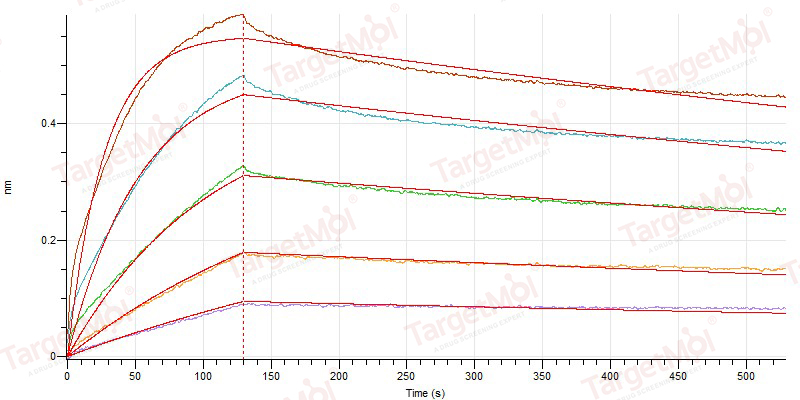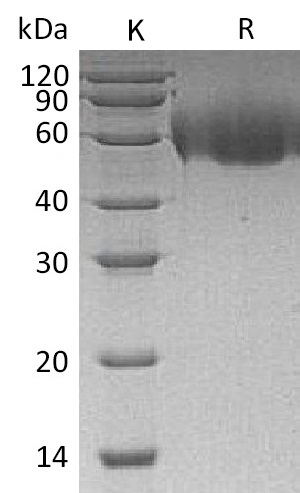 Your shopping cart is currently empty
Your shopping cart is currently empty
CD155/PVR Protein, Human, Recombinant (aa 21-343, His)
Catalog No. TMPJ-00651
Poliovirus Receptor (PVR) is a 70 kDa type I transmembrane single-span glycoprotein that belongs to the nectin-like (Necl) family and was originally identified based on its ability to mediate the cell attachment and entry of poliovirus (PV), an etiologic agent of the central nervous system disease poliomyelitis. PVR contains three Ig-like extracellular domains, a transmembrane segment, and a cytoplasmic tail. The normal cellular function of PVR maybe the involvement of intercellular adhension between epithelial cells. Alternate splicing of the PVR mRNA yields four different isoforms (α, β, γ, and δ) with identical extracellular domains.

CD155/PVR Protein, Human, Recombinant (aa 21-343, His)
Catalog No. TMPJ-00651
Poliovirus Receptor (PVR) is a 70 kDa type I transmembrane single-span glycoprotein that belongs to the nectin-like (Necl) family and was originally identified based on its ability to mediate the cell attachment and entry of poliovirus (PV), an etiologic agent of the central nervous system disease poliomyelitis. PVR contains three Ig-like extracellular domains, a transmembrane segment, and a cytoplasmic tail. The normal cellular function of PVR maybe the involvement of intercellular adhension between epithelial cells. Alternate splicing of the PVR mRNA yields four different isoforms (α, β, γ, and δ) with identical extracellular domains.
| Pack Size | Price | USA Warehouse | Global Warehouse | Quantity |
|---|---|---|---|---|
| 5 μg | $53 | 7-10 days | 7-10 days | |
| 10 μg | $83 | 7-10 days | 7-10 days | |
| 20 μg | $132 | 7-10 days | 7-10 days | |
| 50 μg | $250 | 7-10 days | 7-10 days | |
| 100 μg | $392 | 7-10 days | 7-10 days | |
| 200 μg | $646 | 7-10 days | 7-10 days | |
| 500 μg | $1,220 | 7-10 days | 7-10 days |
Add to Cart
Add to Quotation
In Stock Estimated shipping dateUSA Warehouse [1-2 days] Global Warehouse [5-7 days]
All TargetMol products are for research purposes only and cannot be used for human consumption. We do not provide products or services to individuals. Please comply with the intended use and do not use TargetMol products for any other purpose.
Select Batch
Resource Download
Product Information
| Biological Activity | Loaded Human TIGIT-Fc on Protein A Biosensor, can bind Human PVR-His with an affinity constant of 4.22 nM as determined in BLI assay. (Regularly tested)  |
| Description | Poliovirus Receptor (PVR) is a 70 kDa type I transmembrane single-span glycoprotein that belongs to the nectin-like (Necl) family and was originally identified based on its ability to mediate the cell attachment and entry of poliovirus (PV), an etiologic agent of the central nervous system disease poliomyelitis. PVR contains three Ig-like extracellular domains, a transmembrane segment, and a cytoplasmic tail. The normal cellular function of PVR maybe the involvement of intercellular adhension between epithelial cells. Alternate splicing of the PVR mRNA yields four different isoforms (α, β, γ, and δ) with identical extracellular domains. |
| Species | Human |
| Expression System | HEK293 Cells |
| Tag | C-6xHis |
| Accession Number | A0A0C4DG49 |
| Synonyms | PVS,PVR,Poliovirus Receptor,Nectin-Like Protein 5,NECL-5,CD155 |
| Amino Acid | Trp21-Asn343 |
| Construction | Trp21-Asn343 |
| Protein Purity | Greater than 95% as determined by reducing SDS-PAGE. (QC verified)  |
| Molecular Weight | 58 KDa (reducing condition) |
| Endotoxin | < 0.1 ng/µg (1 EU/µg) as determined by LAL test. |
| Formulation | Supplied as a 0.2 μm filtered solution of 20 mM PB, 150 mM NaCl, pH 7.4. |
| Stability & Storage | Lyophilized powders can be stably stored for over 12 months, while liquid products can be stored for 6-12 months at -80°C. For reconstituted protein solutions, the solution can be stored at -20°C to -80°C for at least 3 months. Please avoid multiple freeze-thaw cycles and store products in aliquots. |
| Shipping | Shipping with blue ice. |
| Research Background | Poliovirus Receptor (PVR) is a 70 kDa type I transmembrane single-span glycoprotein that belongs to the nectin-like (Necl) family and was originally identified based on its ability to mediate the cell attachment and entry of poliovirus (PV), an etiologic agent of the central nervous system disease poliomyelitis. PVR contains three Ig-like extracellular domains, a transmembrane segment, and a cytoplasmic tail. The normal cellular function of PVR maybe the involvement of intercellular adhension between epithelial cells. Alternate splicing of the PVR mRNA yields four different isoforms (α, β, γ, and δ) with identical extracellular domains. |
Dose Conversion
You can also refer to dose conversion for different animals. More
Calculator
Tech Support
Please read the User Guide of Recombinant Proteins for more specific information.
Generate Quote
Catalog No.: Cas No.:
Add
| Size | Quantity | Unit Price | Amount | Operation |
|---|
Generate Quote

Copyright © 2015-2026 TargetMol Chemicals Inc. All Rights Reserved.



